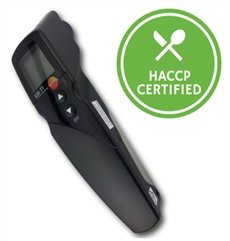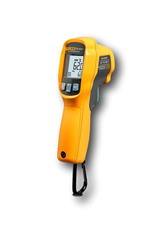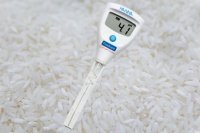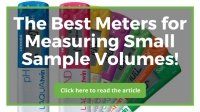How to Ensure Accurate Results from Your Infrared Thermometer

Choosing the Right Infrared Thermometer for Your Application – How is it Done?
Before considering measuring techniques, you need the right infrared thermometer for your intended tasks. To ensure you choose the best tool for your application, you must consider the following:
1. What are you measuring?
Infrared thermometers are often more specialised than other types of scientific instruments. You can encounter models designed for industrial use, food safety, human use, general use, and more. Select an Infrared thermometer suitable for your intended application, especially when considering infrared thermometers for measuring the human body.
Learn more about IR thermometers for human use and what sets them apart in the Instrument Choice article Introducing Handheld IR Thermometers for Human-use.
2. What is the Required Temperature Range?
Select a unit capable of measuring the temperatures that occur in the environments that matter to you. For thermometers that measure the human body, a slim range from around 32°C to 42.5°C is fine, but industrial type laser thermometers may need to capture temperatures anywhere from
-60°C to well over 500°C.
3. Required Accuracy?
Accuracy refers to the closeness of a measurement to a specific value. Generally, high range thermometers trade-off accuracy in favour of an extensive measurement capability. On the other hand, human use thermometers must be very precise.
4. Do You Need a Laser Pointer?
You may or may not need a laser pointer on your infrared thermometer; it all depends upon your intended use. Human use thermometers often don’t have laser pointers. General use, food, and industrial IR thermometers may have single or dual point laser targeting. What is the difference? Single point devices will guide you to the centre of a measurement area, and dual-point laser pointers typically highlight the outer edge of the zone you wish to assess.
Location, Location, Location
The ambient environment can impact your non-contact infrared thermometer readings. Conditions such as drafts, reflected/radiant heat sources, and direct sunlight can create measurement errors. For this reason, most thermometer specifications will provide details on the ideal operating temperature and storage conditions for your unit. Follow these guidelines for best results.
When moving through substantially different environments, i.e., if you have moved from the outdoors on a cool day to a heated indoor environment (or vice versa), always allow your infrared thermometer time to adapt to the new space. Most product specifications will state the time required for this adjustment - typically between 10-20 minutes.
In a nutshell, allowing for adaption time and selecting the best possible environment will reduce the risk of measurement error.
The Method of Use
To follow Best Practice and to operate your equipment to its full potential, you must carefully read and apply the contents of your infrared thermometer’s user manual. When comprehending these instructions, it helps to understand two terms; the distance-to-spot ratio and emissivity.
1.Distance-to-Spot Ratio
The Distance-to-Spot Ratio is the size of the area measured against the thermometer’s distance from the sample. This ratio will determine how much a measured area grows or shrinks as the distance between your device and the measured object increases or decreases. Knowing your distance-to-spot ratio is essential to avoid taking measurements from outside your intended measurement area.
| IC TIP: Need to measure a small area from a distance? Find an infrared thermometer with a higher distance to spot ratio.Want to measure the temperature of a sample at close range? A low distance to spot ratio will suit your application. |
2.Emissivity
Emissivity is a measure of how efficiently a surface emits energy as infrared radiation as measured on a scale of 0 to 1. An object with a 0 emissivity value is classed as a perfect reflector, while objects that score 1 absorb all incoming radiation and do not reflect any. The emissivity of many objects falls within a range of 0.95, which is the default setting for most infrared thermometers. This default setting means that for most measurement applications, you won’t need to make special adjustments for emissivity. See Table 1 (below) for examples of emissivity values.
| Material | Emissivity |
| Polished aluminium | 0.05 |
| Asbestos board | 0.96 |
| Black electrical tape | 0.95 |
| White paper | 0.90 |
| Black paper | 0.95 |
| Clear plastic | 0.94 |
| Concrete | 0.95 |
| Ice | 0.97 |
| Skin | 0.98 |
| Typical Foods | 0.80-0.95 |
Table 1 Emissivity values of everyday objects
Examples
Instrument Choice Scientists have prepared some examples of infrared thermometers that differ significantly from one another. The contrasting specifications demonstrate the variability you may find between makes and models, which is why we emphasise it is essential to select the right thermometer for your application.
 General-Use
General-Use
IR Thermometer, 1 Point Laser, Calibration, Alarm
Product Code: 0560-8311
For an ideal general use thermometer that’s packed with features, you can’t go past the 05660-8311. We like the audible and visual alarms, backlit display, hold function, and laser sighting. This infrared thermometer is suited for a wide range of applications and industries that include factories, kitchens, various workplaces, in the home (we're looking at you pizza oven owners), and more.
Also available with dual-point laser sighting.
Specifications
Uses: General (not suited for human use)
Temperature Range: -30°C to +400°C
Accuracy: ±1.5°C or 1.5% of mv (+0.1°C to +400°C), ±2°C or ±2 % of mv (-30°C to 0°C)
Laser: Single-point laser
Distance to spot ratio: 10:1 distance to spot ratio
Emissivity: Adjustable from 0.1 to 1.0
Human-Use
Non-Contact Forehead Thermometer
Product Code: IC-15004
The IC-15004 is a forehead thermometer that’s straightforward to use. To take a measurement, point the IR thermometer at a person’s forehead from a distance of 5cm, and instantly, a temperature reading will appear on the large LCD. This unit features selectable temperature units (Celcius or Fahrenheit), user-adjustable alarms, and a memory that holds up to 32 data points.
Specifications
Uses:Non-contact forehead temperature measurements and surface (general) mode at the flick of a switch.
Temperature Range: Body:32°C to 42.5°CSurface:0°C to 60°C
Accuracy: 0.3°C
Laser: None
Distance to spot ratio: Forehead measuring distance 5-15 cm
Emissivity: Pre-set
Industrial
FLUKE 62 MAX+, IR Thermometer
Product Code: FLUKE-62-MAX-PLS
The Fluke-62-Max-PLS can endure the toughest of industrial conditions. The device is IP54 rated, 3-metre drop tested, ergonomic, lightweight, and reliable.
Specifications
Uses: Industrial, building, manufacturing
Temperature Range:30°C to 650°C
Accuracy:±1.0°C or 1.0% of reading, whichever is greater
-10° to 0°C: ± 2.0
-30°C to -10°C: ± 3.0
Laser: Dual-laser
Distance to spot ratio: 12:1 distance to spot ratio
Emissivity: Adjustable from 0.10 to 1.00
Food Applications
Waterproof Infrared & Probe Thermometer
Product Code: IC-0560-1040
The IC-0560-1040 combines an Infrared non-contact temperature measurement with a fold-out probe for core temperature measurements. It is HACCP compliant, which makes it ideal for all sorts of applications within the food sector.
Specifications
Uses: Food manufacture and storage, supermarkets, home use, HACCP, quality assurance
Temperature Range: -30 to +250 °C
Accuracy: ±2.5 °C (30.0 to 20.1 °C), ±2.0 °C (20.0 to 0.01 °C) ±1.5 °C, or ±1.5 % of the measuring value (+0.0 to +250.0 °C)
Laser: Dual-laser
Distance to spot ratio: 10:1 distance to spot ratio
Emissivity: Adjustable from 0.10 to 1.00
Conclusion
That completes the Instrument Choice Scientists’ guide to ensuring reliably accurate results from your Infrared Thermometer.
In a nutshell:
- Please choose the right equipment for your application(s) using the criteria as provided by our scientists within this article
- Understand the content in your device’s user manual; and
- If you need more information on any of the products or tips listed above, speak with a friendly, knowledgeable Instrument Choice Scientist. We're here to help!
Call 1300 737 871 or email customer-service@instrumentchoice.com.au.

Also interesting
The IC-HI981035 Sushi pH Meter measures the ph of sushi rice to ensure it meets both food hygiene standards and your hazard analysis critical control point (HACCP) requirements. With easy one-button operation, this pH meter by Hanna Instruments is straightforward to use and maintain.
Learn how to measure the pH of sushi rice with accuracy using the IC-HI981035 Hanna pH meter.

Over 75 years, Horiba has established an outstanding reputation for creating practical and precise water quality measuring devices. Horiba's extensive LAQUAtwin series of eleven portable pocket meters measures seven different water quality parameters that perform well in numerous field and laboratory applications.
This article examines a signature attribute of these meters, which is their outstanding ability to measure small volumes. The Instrument Choice Scientists overview why and where small volume measurement is critical and how LAQUAtwin meters achieve the seemingly impossible!
Reduce the risk of sample contamination and waste.

